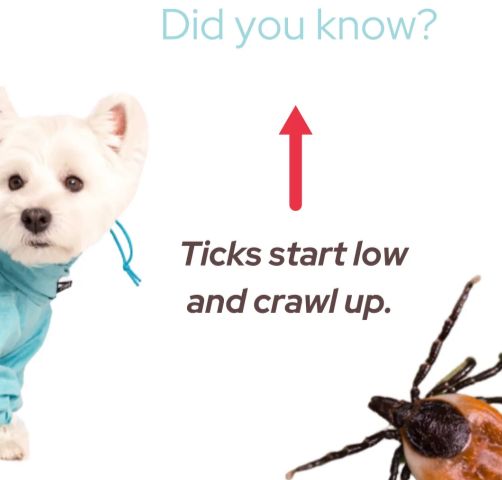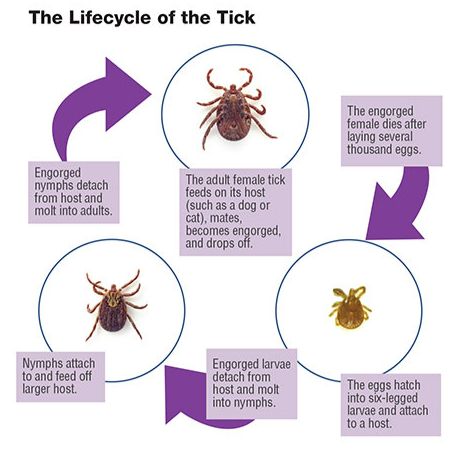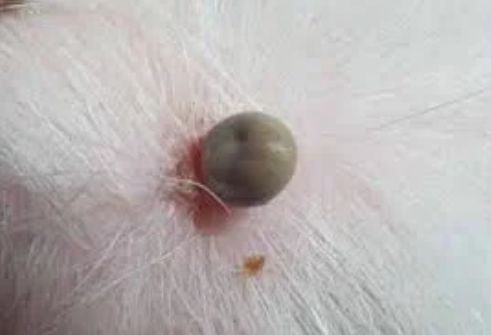Ticks are ambushers. They live a simple life waiting for a meal to wander close by. They don’t run. They don’t jump. They don’t fly. They just wait.
Ticks don’t have very good eyes. They can sense movement, and that’s just about it. Their primary way of detecting their prey is through the use of organs called Haller’s cups on their front legs.

Ticks find their hosts by detecting animals breath and body odors, or by sensing body heat, moisture, and vibrations. Some species can even recognize a shadow.
Ticks pick a place to wait by identifying well-used paths. Then they wait for a host, resting on the tips of grasses and shrubs.
Ticks can’t fly or jump, but many tick species wait in a position known as “questing” ( ticks wave their forelegs).

While questing, ticks hold onto leaves and grass by their third and fourth pair of legs. They hold the first pair of legs outstretched, waiting to climb on to the host. When a host brushes the spot where a tick is waiting, it quickly climbs aboard. Some ticks will attach quickly and others will wander, looking for places like the ear, or other areas where the skin is thinner.
Haller’s organs allow ticks to sense the heat, carbon dioxide and odor given off by warm-blooded animals 3 or 4 yards (2,7-3,7 m) away.
If you find a tick crawling on your arm or in your hair, it climbed up there from somewhere around your ankles.

When the message that a mammal is close by is sent to the tick’s tiny brain, it raises its front legs (which have hooks like claws), using its other legs to hold onto a blade of grass or a low twig. Once the unsuspecting host brushes by the tick’s perch, it uses its claws like grappling hooks and hitches a ride.
Ticks transmit pathogens that cause disease through the process of feeding.
Ticks Life Stages and Feeding Process
Most ticks go through four life stages: egg, six-legged larva, eight-legged nymph, and adult.
After hatching from the eggs, ticks must eat blood at every stage to survive. Ticks that require this many hosts can take up to 3 years to complete their full life cycle, and most will die because they don’t find a host for their next feeding.


Depending on the tick species and its stage of life, preparing to feed can take from 10 minutes to 2 hours. When the tick finds a feeding spot, it grasps the skin and cuts into the surface.
The tick then inserts its feeding tube. Many species also secrete a cement-like substance that keeps them firmly attached during the meal. The feeding tube can have barbs which help keep the tick in place.
Ticks also can secrete small amounts of saliva with anesthetic properties so that the animal or person can’t feel that the tick has attached itself. If the tick is in a sheltered spot, it can go unnoticed.
A tick will suck the blood slowly for several days. If the host animal has a bloodborne infection, the tick will ingest the pathogens with the blood.

Small amounts of saliva from the tick may also enter the skin of the host animal during the feeding process. If the tick contains a pathogen, the organism may be transmitted to the host animal in this way.
After feeding, most ticks will drop off and prepare for the next life stage. At its next feeding, it can then transmit an acquired disease to the new host.
Tick-borne pathogens are not the only problem due to tick infestation. When ticks feed on their host, they draw blood and cause damage to the skin. Injury of skin and subcutaneous tissues leads to edema, pruritus, erythema, scaling, and ulceration. Excoriation can result in secondary bacterial infections. Along with these physical damages, ticks affect the productivity of animals by disturbing their normal behavior.
Tick-borne bacterial diseases not only affect the productivity of animals but also have zoonotic importance. Lyme disease is one of the major tick-borne bacterial diseases, which is rapidly spreading in Europe. It is estimated that about 10% of the total population of ticks are positive in Europe, and annually more than 85,000 human cases of Lyme are reported from the European countries. Lyme disease also affects domestic animals. Clinical signs and symptoms of Lyme disease in animals include lethargy, anorexia, lameness, and urinary disorder.

Ticks can transmit many blood protozoan parasites to their vertebrate hosts. Among these, two main groups of tick-borne diseases are theileriosis and babesiosis. Tropical theileriosis is characterized by lymph nodes swelling, high fever, and dyspnea. In bovines, animals having babesiosis show clinical signs including hemoglobinuria, jaundice, rapid breathing, and high fever.
Can ticks smell?
“If you ever find a tick before it finds you—that is when it’s still hanging out on vegetation hoping you’ll brush past it—you may notice the little bloodsucker waving its “arms in the air like it just don’t care.” They’re waving their arms because they are trying to get a whiff of you.” Meredith Swett Walker
While insects primarily smell with their antennae, ticks are not insects; rather, they’re arachnids, and they don’t have antennae. Instead, a tick smells using a structure on its forelegs called the Haller’s organ. The Haller’s organ is described as a tiny “sensory pit” that can detect chemicals like carbon dioxide, ammonia, or pheromones. It can even sense humidity and infrared light, which includes body heat emitted by the warm, blood-filled creatures that the tick wants to find.
When seeking a host, ticks wave their forelegs – do “questing” process. The ticks’ forelegs feature tiny sensory pits called Haller’s organs used to detect a passing host.
A better understanding of how ticks find their hosts may aid in reducing disease transmission.

Haller’s organ seems significantly different in each species of tick. In some species, the morphology of the Haller’s organ is significantly different between females and males.
The Haller’s organ is an example of a multi-functional sensor that is very sensitive yet rather simple in design, compared to a vertebrate’s nose.
If we can better understand the structure ticks use to find us (and their other hosts,) we might devise ways to elude them. This could reduce transmission of serious diseases, as well as make ticks less of a creepy problem for people who work or play outdoors.


Ticks Use Haller’s Organ to “Smell”
Ticks utilize a small sensory structure on their forelegs called the Haller’s organ to locate hosts. Ticks lift up and wave their forelegs similarly to the way insects move their antennae lead to the conclusion that the Haller’s organ serves an olfactory function.
Haller’s organ helps ticks find hosts and mates because it functions as a chemoreceptor of carbon dioxide, ammonia, and other chemicals such as pheromone. The Haller’s organ is also used to detect infrared light and humidity, which is presumably important during host acquisition and when females seek an oviposition site.
How the different components of the Haller’s organ and its overall structure achieves these sensory functions, and how this then translates into observed tick behaviors, is not completely understood.

Haller’s organs range in diameter from 10 to 100 µm and consist of a capsule aperture and an anterior pit which contains a group of setae.
Flea and Tick Prevention
While often the same products that are used to combat ticks are used to combat fleas, there are substantial differences between flea and tick control. One of the major differences is in the number of species that confront pets: one predominant flea species and at least 10 different tick species may be encountered. There can be remarkable regional variability in the number and diversity of tick species that infest dogs.

Although recent pharmaceutical advances have been made in flea reproduction control, such advances in the area of tick control are lacking. Our ability to manage tick reproduction is limited, if not almost nonexistent.
In most flea infestations, we have the opportunity to control flea reproduction by either killing fleas before they can reproduce or killing flea eggs, because we can often target the primary reproductive host: the flea-infested dog or cat.
But when dealing with ticks, the problem is that the majority of the reproducing ticks are not on the dogs or cats, but on their natural wildlife hosts. Because we are limited in our ability to manage ticks on wildlife, reinfestation of pets is a common occurrence, and protracted use of acaricides as preventives is routine in many areas.


- DEET,
- 1-methyl-propyl-2- (hydroxyethyl)-1-piperidinecarboxylate (picaridin),
- p-menthane-3,8-diol (PMD),
- ethyl butylactyloaminopropionate ( IR3535),
- 1S,2S-2-methylpiperidinyl-3-cyclohexene-1-carboxamide (SS220),
- racemic 2-methylpiperidinyl-3-cyclohexene-1-carboxamide (AI3-37220)
- and synthethic pyrethroid – 3-phenoxybenzyl-cis-trans-3(2,2 dichlorovinyl)-2,2-dimethylcyclopropancarboxylate (permethrin) – an acaricide with repellent properties.
- To achieve the protection from tick bites by avoiding attachment and/or engorgement by the arthropod, acaricides with repellent properties, such as synthetic pyrethroid-permethrin are used. This pyrethroid is an acaricide of choice used for clothing impregnation, which is effective for personal protection against all three parasitic stages of western black-legged ticks.
- Products based on natural compounds, e.g. eugenol from Ocimum basilicum, 2-undecanone originally derived from wild tomato, geraniol – a natural product extracted from plants, and many others, represent an interesting alternative to common synthetic repellents and/or acaricides.
National Library of Medicine https://pubmed.ncbi.nlm.nih.gov/23311778/

Tick control can be extremely difficult and because ticks are vectors of a variety of bacterial and protozoal diseases, we should have an understanding of the ecology of the ticks encountered in the area in which we live and spend time.
Because tick products do not kill or repel all ticks instantly, we may get the false impression that the products are not performing as well as in the past. Instead of setting the unrealistic expectations, we should consider more safety options, like covering dogs body with light clothes, avoiding areas highly tick-infested or rarely visited by others (with more hungry ticks).

A 95% effective flea product may provide great client satisfaction, while a similarly effective tick product may be perceived as a failure.
Pet owners should be aware of a need to reduce tick-borne disease and a lack of 100% efficacy, occasionally additional control measures are needed (check our linen summer dog overalls that help to cover dogs body and reduce risk to catch ticks). Restricting pet access from tick-infested environments may be necessary.

